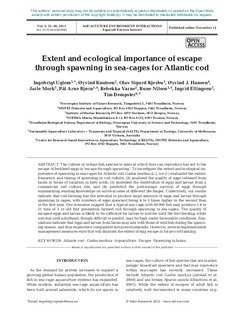| dc.contributor.author | Uglem, Ingebrigt | |
| dc.contributor.author | Knutsen, Øyvind | |
| dc.contributor.author | Kjesbu, Olav Sigurd | |
| dc.contributor.author | Hansen, Øyvind J | |
| dc.contributor.author | Mork, Jarle | |
| dc.contributor.author | Bjørn, Pål Arne | |
| dc.contributor.author | Varne, Rebekka | |
| dc.contributor.author | Nilsen, Rune | |
| dc.contributor.author | Ellingsen, Ingrid H. | |
| dc.contributor.author | Dempster, Timothy David | |
| dc.date.accessioned | 2018-08-01T06:52:48Z | |
| dc.date.available | 2018-08-01T06:52:48Z | |
| dc.date.created | 2012-11-19T13:01:02Z | |
| dc.date.issued | 2012 | |
| dc.identifier.citation | Aquaculture Environment Interactions. 2012, 3 (1), 35-51. | |
| dc.identifier.issn | 1869-215X | |
| dc.identifier.uri | http://hdl.handle.net/11250/2507051 | |
| dc.description.abstract | The culture of certain fish species to sizes at which they can reproduce has led to the escape of fertilised eggs or ‘escape through spawning’. To investigate the extent and ecological importance of spawning in sea-cages for Atlantic cod Gadus morhua (L.), we (1) evaluated the extent, frequency and timing of spawning in cod culture; (2) analysed the quality of eggs released from farms in terms of variation in fatty acids; (3) modelled the distribution of eggs and larvae from a commercial cod culture site; and (4) predicted the post-escape survival of eggs through summarizing existing knowledge on survival rates of different life stages. Collectively, our results indicate that cod farming has the potential to produce large amounts of eggs and larvae through spawning in cages, with numbers of eggs spawned being 4 to 5 times higher in the second than in the first year. Our scenarios suggest that a typical sea-cage with 60 000 fish may produce 1.4 to 21 tons of 3 yr old first generation farmed cod through spawning in sea-cages. The quality of escaped eggs and larvae is likely to be sufficient for larvae to survive until the first feeding, while survival until adulthood, though difficult to predict, may be high under favourable conditions. Simulations indicate that eggs and larvae from farms may mix with those of wild fish during the spawning season, and thus experience comparable larval environments. However, several implementable management measures exist that will diminish the extent of egg escape in future cod farming. Atlantic cod · Gadus morhua · Aquaculture · Escape · Spawning in farms | |
| dc.description.abstract | Extent and ecological importance of escape through spawning in sea-cages for Atlantic cod | |
| dc.language.iso | eng | |
| dc.title | Extent and ecological importance of escape through spawning in sea-cages for Atlantic cod | |
| dc.title.alternative | Extent and ecological importance of escape through spawning in sea-cages for Atlantic cod | |
| dc.type | Peer reviewed | |
| dc.type | Journal article | |
| dc.description.version | publishedVersion | |
| dc.source.pagenumber | 35-51 | |
| dc.source.volume | 3 | |
| dc.source.journal | Aquaculture Environment Interactions | |
| dc.source.issue | 1 | |
| dc.identifier.doi | 10.3354/aei00049 | |
| dc.identifier.cristin | 963192 | |
| cristin.unitcode | 7543,1,5,0 | |
| cristin.unitname | Produksjonsbiologi | |
| cristin.ispublished | true | |
| cristin.fulltext | original | |
| cristin.qualitycode | 1 | |
